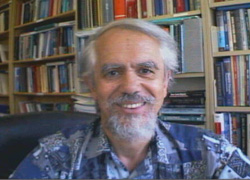Responses to questions on VR and Haptics.
 In your opinion, what is virtual reality? And what are haptics systems?
In your opinion, what is virtual reality? And what are haptics systems?
“Virtual Reality” is a term that presents an oxymoron, as something cannot be both “virtual” and “real” at the same time! Nevertheless, the term is understood to mean a technology giving a synthetic 3D representation or simulation of the real world, using graphics, images or both. Haptics may also be part of a VR system.
Haptics, a term coming form the Greek verb “haptesthai” (meaning “to touch”), refers to technology that allows a user to capture the feeling of touch by a mechanical device connected to a computer and providing the user with force, torque, vibration or motion feedback.
What is the origin of virtual reality?
Wikipedia reports that the origin of the term “virtual reality”, coined by Myron Krueger, can be traced back to the French playright, poet, actor and director Antonin Artaud in his 1938 book “The Theater and its Double”.
What is the origin of haptics systems?
It seems again that the use of haptic devices in entertainment first appeared in the 1932 futurist fiction book “Brave New World” by Aldous Huxley. (Wikipedia): “The author described a future entertainment theater where the arm rests of the seats had positions for the hands to rest that gave haptic stimulation.”
What do you think is the state of the art in virtual reality technology? Which are its most interesting expressions?
Virtual Reality technology has many advanced simulations in medical training, industrial training, military training and many others.
Which kind of virtual technology is your research group carrying out? Why are you focusing on this kind of devices and what improvements have you made so far?
We have used Virtual Reality and haptics in simulations for Industrial Training, Medical Training, eLearning, eCommerce and Security.
Who do you think are the leading researchers in your field? And What researchers have influenced your work the most in the field of virtual reality?
In human animations in Virtual Environments, the leader in my view is Prof. Nadia Magnenat-Thalmann at the MIRA lab, Univ. of Geneva. In simulations of artificial fish and animals, Prof. Dimitris Terzopoulos of UCLA in the US is a leader.
Do you think virtual reality technology will ever spread to the public at large? When may that happen and with what kind of technology?
American inventor, entrepreneur, computer scientist, best-selling author Raymond Kurzweil, in his book “The Age of the Emotional Machine”, predicts that in very few years all human-to-human communications will be done through Virtual Reality, in multimedia kiosks that he calls “Sensoria”, in which all human senses can be captured and electronically transmitted.
How will quantic computers alter the use of the Internet and virtual reality?
Quantum Computing will certainly speed up computations by many orders of magnitude, that making 3D tele-presence by Virtual Reality over the future Internet a reality.
Do you think virtual reality technology will develop in the direction envisioned by Jaron Lanier and Ivan Sutherland?
I do not know what vision they had!
What kind of interfaces are you currently working on?
Gestural Interfaces and multi-modal Interfaces (gestures and speech).
In your opinion, which are nowadays the most innovative companies and research centres (other than MIT, Silicon Valley, C.E.R.N and UCN)? - What are the leading bibliographical references on virtual reality you usually work with?
The Advanced Telecommunications Research Labs (ATR) in Kyoto, Japan, are certainly leaders in the field. Also, the Human Interface Technology (HIT) lab at the Univ. of Washington in Seattle and the group of Prof Thomas A. Defanti at the EVL Laboratory of the Univ. of Illinois in Chicago, the inventors of the CAVE system.
In your view, what’s Spain’s rank in the research field of virtual reality? Why?
That, I cannot tell you. I have been, however, very impressed by the laboratory and group of Prof. Louis Pastor at the Univ. Rey Juan Carlos in Mostolles, Madrid. Also, by the VR and Haptics research done at the Research centres CEIT (Univ. of Navarra at San Sebastian) and VicomTech (also at San Sebastian).
What applications you are currently working on?
We are working with applications of VR, Gestural Interfaces and Haptics in Security as also Games.
How much does it cost today an equipment of virtual reality? Does how much cost him to a laboratory of virtual reality a basic equipment to work? And of what does this equipment consist?
When I bought my first VR system, based on Silicon Graphics technology, it cost about $2.5 million. Later, we built another one for $200,000, using PC technology. Today, we can build VR systems with $10,000-20,000. Powerful Graphics cards for PCs have made the costs very reasonable. Haptics equipment costs from $250 to $100,000 per piece, thus it is still expensive.
How do you see the future of virtual reality technology?
I see VR technology as a facilitator for human training and learning. I believe on Kurzweil’s prediction that we will soon have excellent quality Tele-presence systems using VR and haptics for Human-to-human long-distance communications.
Read more:
- Download Press Release
 (107 KB)
(107 KB)

